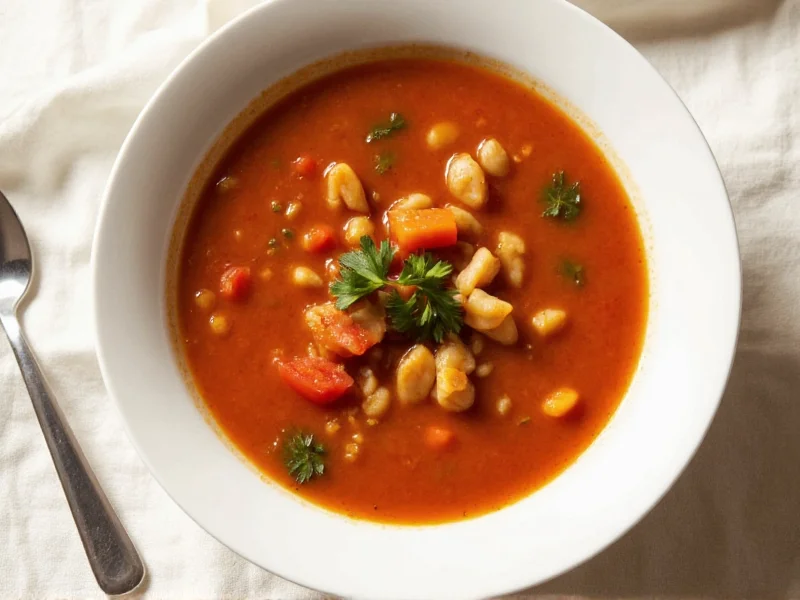The Essence of Authentic Minestrone Soup
Minestrone soup represents Italy's culinary philosophy of transforming humble ingredients into nourishing meals. Originating from the Italian phrase “minestra” meaning “soup” and “one” as a augmentative, this dish celebrates seasonal produce and resourcefulness. Unlike rigid recipes, traditional minestrone varies by region and season—Northern versions often include rice while Central Italy prefers small pasta shapes like ditalini. The foundation remains consistent: a flavorful soffritto base, rich vegetable broth, and the signature addition of cannellini beans for creaminess.
Essential Ingredients and Why They Matter
Understanding each component's role ensures your minestrone achieves balanced flavor and texture. The soffritto trio (onion, carrot, celery) builds aromatic depth, while tomato products provide acidity to cut through the soup's richness. Beans contribute protein and body, and the Parmesan rind—a chef's secret—adds umami without overpowering saltiness. Unlike many online recipes, authentic minestrone avoids meat stocks to maintain its vegetarian integrity while remaining deeply savory.
| Ingredient | Quantity | Preparation Notes |
|---|---|---|
| Extra virgin olive oil | 3 tbsp | Use high-quality for sautéing |
| Yellow onion, diced | 1 medium | Fine dice ensures even cooking |
| Carrots, diced | 2 medium | Uniform 1/4-inch pieces |
| Celery stalks, diced | 2 | Include leafy tops for flavor |
| Garlic cloves, minced | 3 | Add after vegetables soften |
| Cannellini beans | 2 cans (15 oz each) | Rinsed and drained |
| Diced tomatoes | 1 can (28 oz) | With juices |
| Vegetable broth | 6 cups | Low-sodium preferred |
| Zucchini, diced | 2 medium | Add with green beans |
| Green beans, trimmed | 1 cup | Cut into 1-inch pieces |
| Small pasta (ditalini) | 3/4 cup | Cook separately to prevent mushiness |
| Parmesan rind | 1 piece (2x3 inch) | Optional but recommended |
| Fresh basil | 1/4 cup, chopped | Add just before serving |
Step-by-Step Preparation Guide
Begin by heating olive oil in a 6-quart Dutch oven over medium heat. Add the soffritto (onion, carrots, celery) and sauté for 8-10 minutes until softened but not browned—this develops flavor without bitterness. Stir in garlic and cook for 1 minute until fragrant. Deglaze the pot with 1/2 cup broth, scraping up any browned bits for maximum flavor extraction.
Add remaining broth, diced tomatoes with juices, zucchini, green beans, and Parmesan rind. Bring to a gentle boil, then reduce heat to low. Cover and simmer for 20 minutes to allow flavors to meld. Stir in rinsed cannellini beans and continue simmering for another 10 minutes. Meanwhile, cook pasta separately according to package directions, rinse under cold water, and set aside.
Just before serving, add cooked pasta to the soup. Remove Parmesan rind (or leave in for stronger flavor). Stir in fresh basil and adjust seasoning with sea salt and black pepper. For optimal texture, let the soup rest for 15 minutes off heat before serving—this allows flavors to fully integrate while preventing overcooking of vegetables.
Avoiding Common Minestrone Mistakes
Many home cooks compromise their minestrone through preventable errors. Overcooking vegetables destroys texture—add delicate ingredients like spinach in the final 5 minutes. Using pre-cooked pasta in the soup causes starch release and mushiness; always cook pasta separately. Skipping the Parmesan rind misses an opportunity for depth without saltiness. Most critically, inadequate simmering time prevents flavor development—20 minutes minimum after adding tomatoes is essential for authentic taste.
Regional Variations and Dietary Adaptations
Traditional minestrone varies across Italy: Ligurian versions feature pesto swirls, while Tuscan iterations include leftover bread. For gluten-free preparation, substitute rice for pasta and ensure broth is certified GF. Vegan cooks can omit Parmesan rind or use mushroom broth for umami. During summer, add fresh tomatoes and basil; in winter, incorporate root vegetables and kale. The soup's beauty lies in its adaptability—use what's seasonal while maintaining the soffritto base and bean foundation.
Storage and Reheating Techniques
Minestrone improves overnight as flavors meld. Store cooled soup in airtight containers for up to 5 days in the refrigerator. For longer storage, freeze without pasta (which becomes mushy when reheated) for up to 3 months. When reheating, add a splash of broth or water to adjust consistency, and stir in freshly cooked pasta separately. Never boil reheated soup—gentle warming preserves vegetable texture.
Serving Suggestions for Perfect Presentation
Serve minestrone in pre-warmed bowls to maintain temperature. Garnish with extra virgin olive oil drizzle, freshly grated Parmesan, and additional basil. Pair with crusty bread for dipping—a classic Italian combination. For elegant presentation, arrange larger vegetable pieces visibly on top. The soup should have a hearty but not thick consistency—if too dense, thin with additional broth. Remember that authentic minestrone is meant to be substantial enough to be a complete meal.











 浙公网安备
33010002000092号
浙公网安备
33010002000092号 浙B2-20120091-4
浙B2-20120091-4